Exam 1
1/73
Earn XP
Description and Tags
** Only intro to coral reef slide deck added so far
Name | Mastery | Learn | Test | Matching | Spaced |
|---|
No study sessions yet.
74 Terms
What percent of the world’s reefs are threatened or destroyed?
70%
True or False: Even though they occupy less than 0.1% of the world’s ocean surface, coral reefs contain 25% of marine species.
True, they are the most diverse ecosystems on earth.
What are coral reefs?
Compacted and cemented underwater structures made from calcium carbonate secreted by the corals.
What are the biological/coral aspects of a reef?
Organic, biogenic
Coral and algal communities
Mostly hermatypic corals, al
What are the geological aspects of a reef?
Carbonate
Buildup
Wave resistant
Cemented, consolidated
How old are coral reefs?
~500 Million years old (late cambrian)
How old is the earth?
4.6 Billion years old
True or False: Corals started as solitary organisms.
True, they eventually evolved to become colonial.
What extinction events have corals gone through?
Ordovician-Silurian extinction: drop in sea level and temp
Devonian (410 MYA): coral re-appeared, formed extensive reef systems
350 MYA corals disappeared from fossils
260 MYA corals reappeared
Permian-Triassic extinction: wiped 96% of marine spp, hypoxia and hypercapnia (high CO2)
65 MYA cretaceous-tertiary mass extinction: meteor
55 MYA Paleocene/Eocene thermal maximum: global warming
20 MYA Great barrier reef formed
What do tropical reefs need to live?
High light levels
High water transparency
Water temp >20 C (68F)
Low nutrient waters
Hard substrate
Good water circulation
Shallow water
Salinity
True or False: Of the 34 animal phyla, 23 are found on reefs.
True, reefs are the most diverse habitat on earth at the phylum level!
Is the Indo-Pacific or Atlantic more diverse? Why?
The Indo-Pacific has higher diversity because of the higher abundance of atolls/rings of islands. It is also older, and has a different dominance of coral species (more fleshy corals)
True or False: Corals are in phylum ctenophora.
False. Corals are in phylum cnidaria (domain eukarya, kingdom animalia)
What is the difference between the polyp and medusa stage of Cnidarians?
Polyp: sac-like stage with mouth and tentacles oriented upward
Medusa: jellyfish-like, basically an upside-down polyp adapted for swimming
How do cnidarians capture prey?
They use cnidocytes with specialized stinging cells called nematocysts.
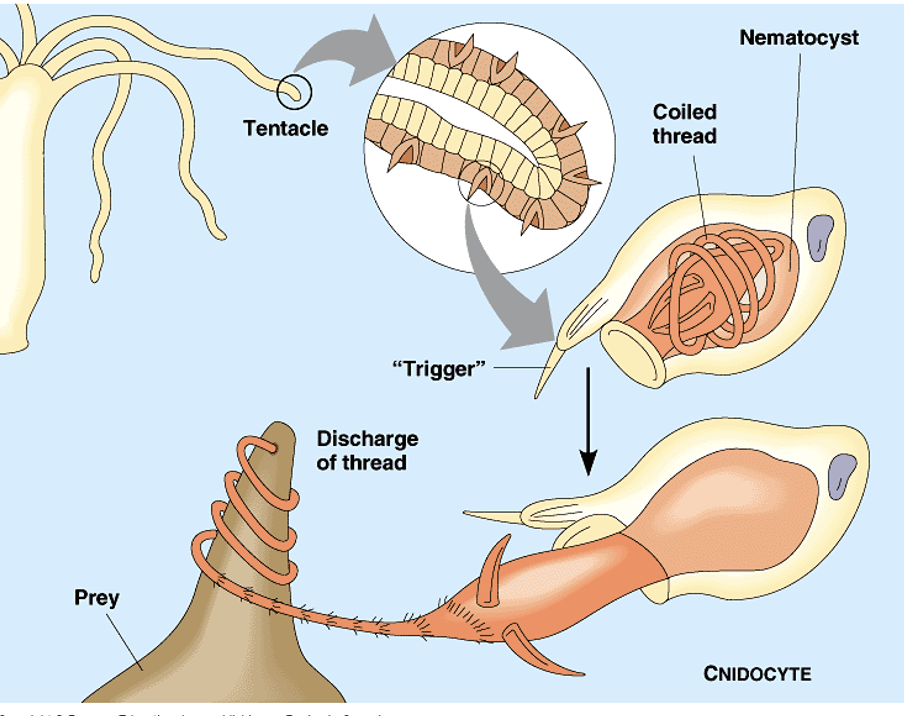
What are examples of anthozoans?
True corals, anemones, sea pens
Solitary or colonial polyps without a medusa stage
What are examples of cubozoans?
Box jellies
What are examples of Hydrozoans?
Siphonophores, hydroids, fire corals, medusae
What are examples of sycphozoans?
true jellies
What subclasses are within class anthozoa?
Zooantharia: true corals, sea anemones
Octocorallia: soft corals, sea pens, sea fans
Carantipatharia: burrowing anemones, black corals
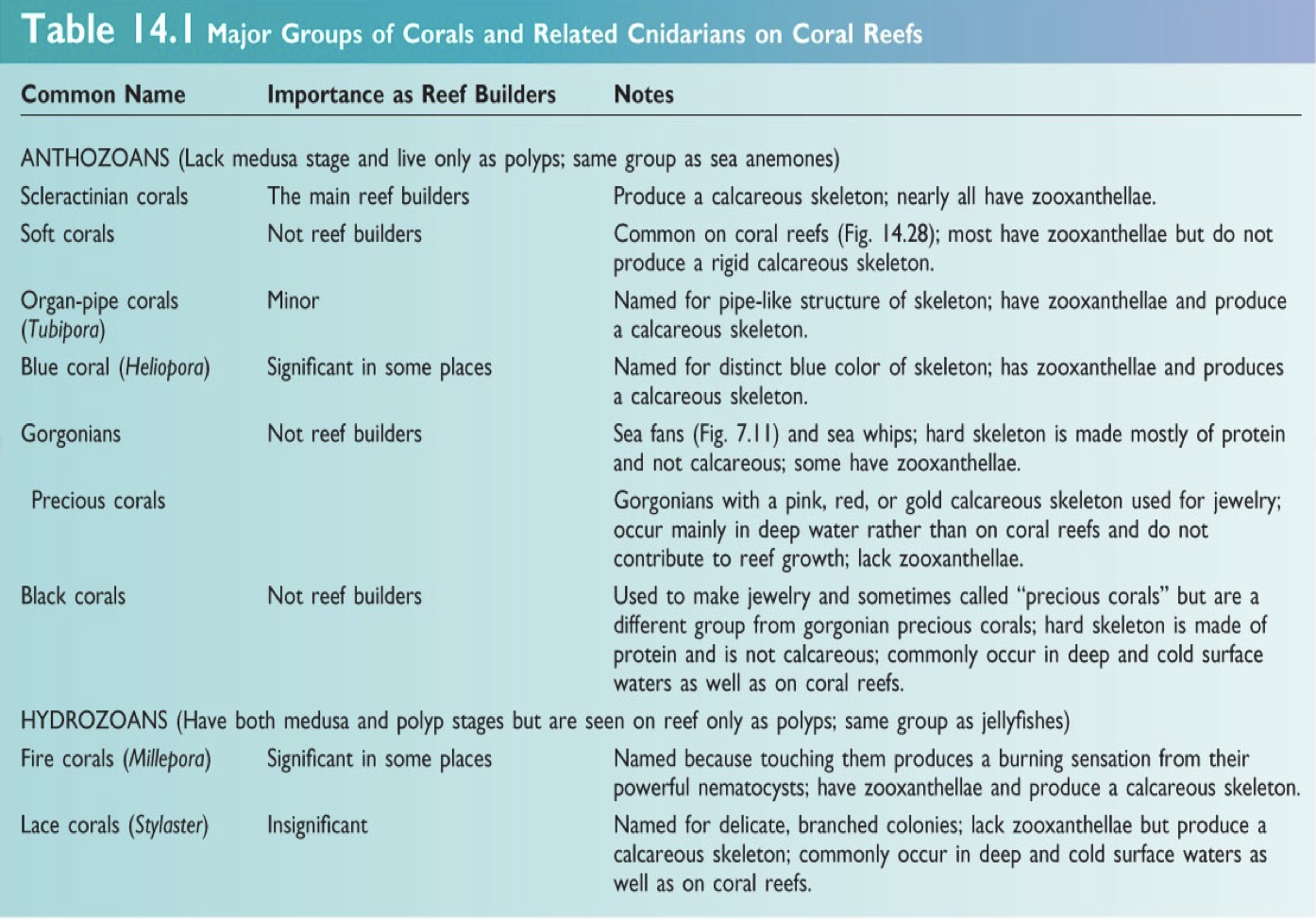
What are hermatypic corals?
Reef building corals, where the polyp produces the calcium carbonate skeleton. They have symbiotic zooxanthellae.
What are scleractinian corals?
Stony or “true” corals, have symbiotic zooxanthellae
What are ahermatypic corals?
Non reef-building corals:
precious corals
black corals
Often LACK zoozanthellae
Octocorallia is also called what?
Alcyonaria
Zoantharia is in what group?
Hexacorallia
What groups are within octocorallia/alcyonaria?
Alcyonacea - soft corals
Helioporacea - blue corals
Pennatulacea - sea pens, sea pansies
What groups are within zoantharia/hexacorallia?
Actinaria - sea anemones
Corallimorpharia - mushroom anemones
Scleractinia - hard corals
Describe a coral polyp:
Cylinder of tissue with a ring of tentacles
Capture food with nematocyst-armed tentacles
Connected by coenosarc
Skeletal calyx - actual CaCO3 cup that forms the connective foundation

What are the coral growth forms?
Plate-like
Foliaceous
Columnar
Massive
Branching
Encrusting
Free-living

What are the 3 classic reef types? Describe each.
Fringing. When corals fringe an island, they develop a fringing reef.
Barrier. A line of reefs form a barrier reef: channel develops between reef and shore.
Atoll. When island subsidence is complete, the remaining ring of reefs enclosing a central lagoon is an atoll.
Describe fringing reefs:
Simplest, most common
Develop near shore in tropics on hard surfaces
Grow in a band along shore
Vulnerable to sediment, freshwater runoff, human disturbance
Longest reef:
Red Sea
2,500 mi
Dry climate/ no streams to bring in sediment/ freshwater
Where is the reef slope, crest, and flat?
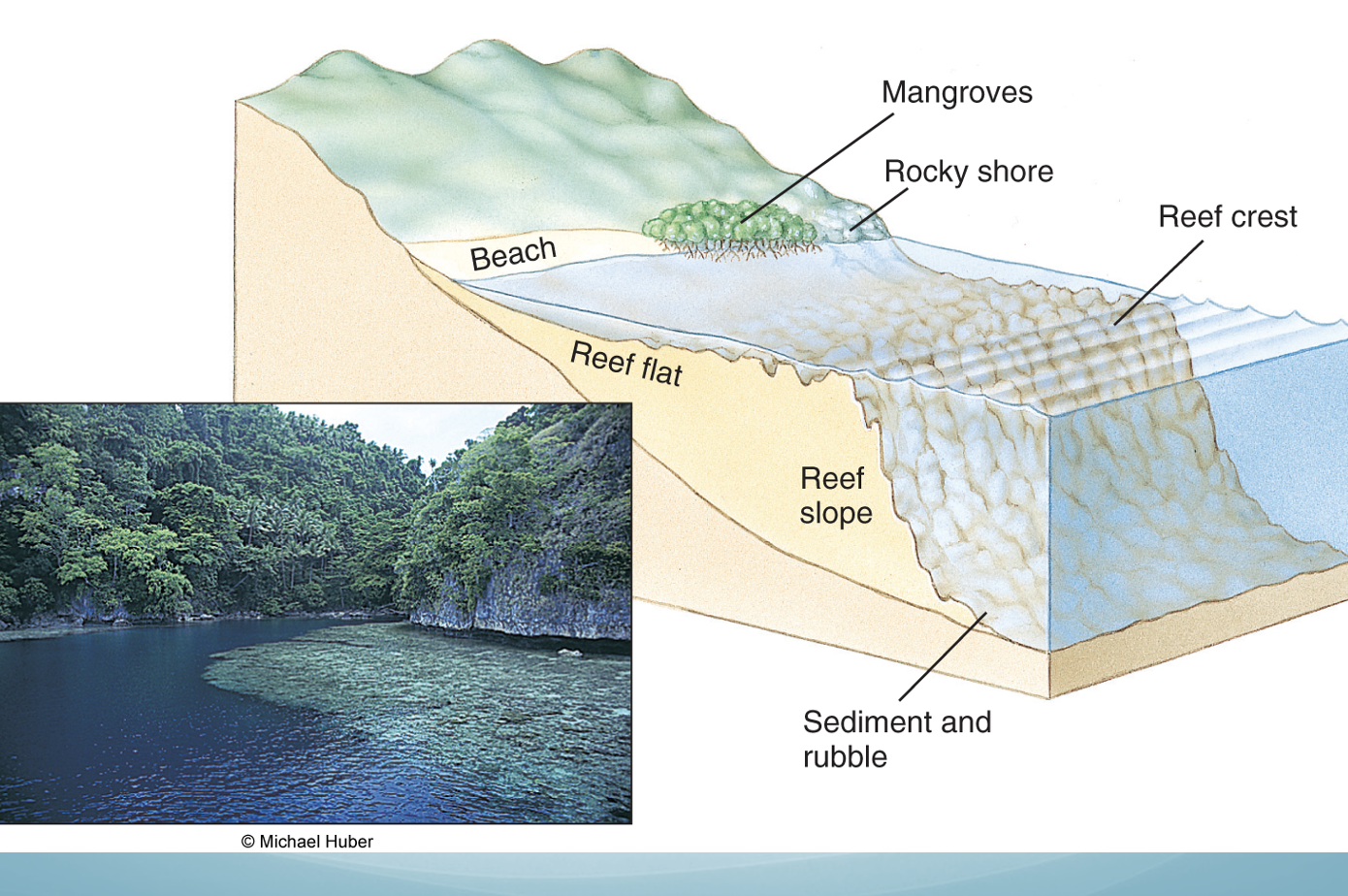
Describe barrier reefs
Similar to fringe reefs
Occur along coast, but farther from shore (~60mi)
Separated from the shore by lagoons
Great Barrier Reef (~1,200 mi)
Describe atoll reefs
Ring of reef
Occur in Indo-West Pacific Regions
Can be far from land
Form when volcanoes or sea mounts subside
Reef builds around “island”
What is a patch reef?
The term “patch reef” is applied to any size reef that does not fit the “Classical Three”
Where are ridge reefs?
Along a continental plate, you can see them from afar ringing around the land mass.
Describe deep-water coral communities:
Known since 18th century
Cold-water corals, mounds
Occur individually or form patch reefs
Over 800 species of cold-water coral, 1,300 in association
Shallow up to 6,000 meters
4-12° C waters
Mostly stony corals, black corals, soft corals
No zooxanthellae or photosynthesis
Capture zooplankton with tentacles
Where are cold-water reefs distributed?
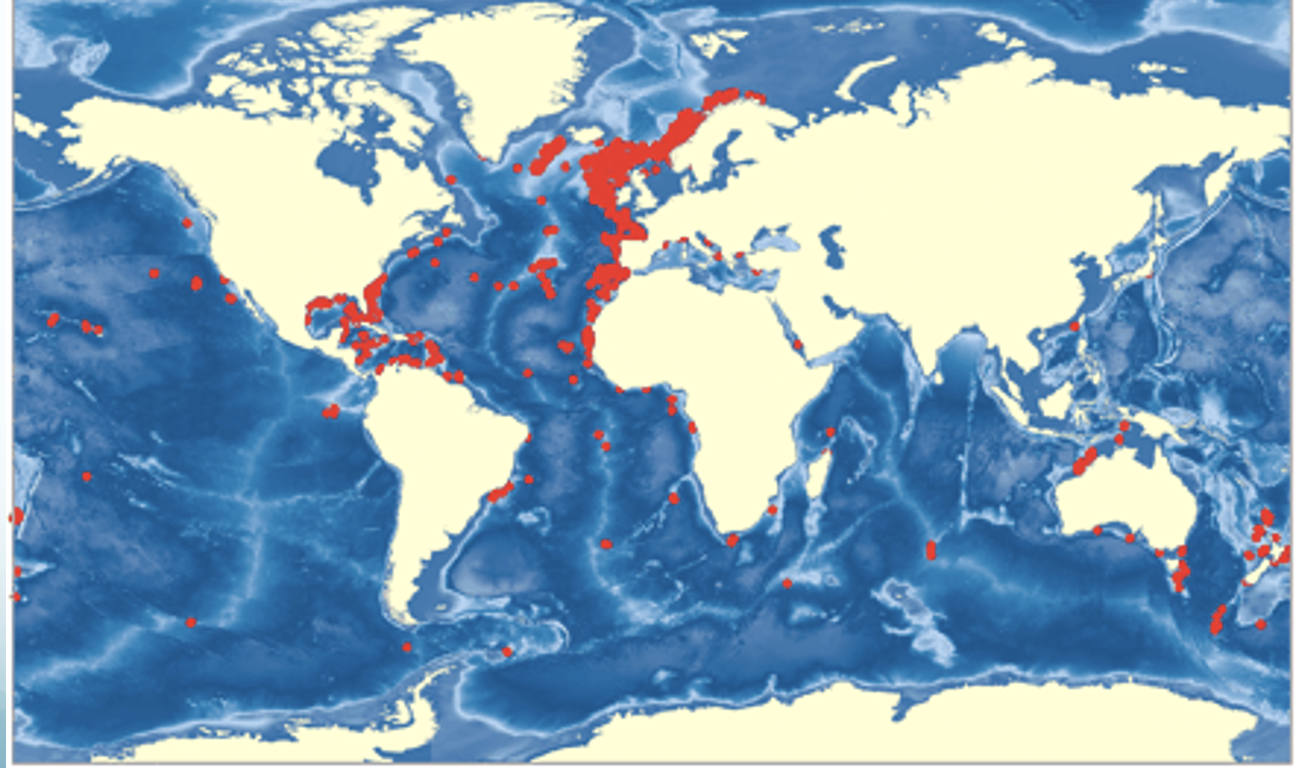
What are the two scales for the life cycles of corals?
Biogenic and glacial
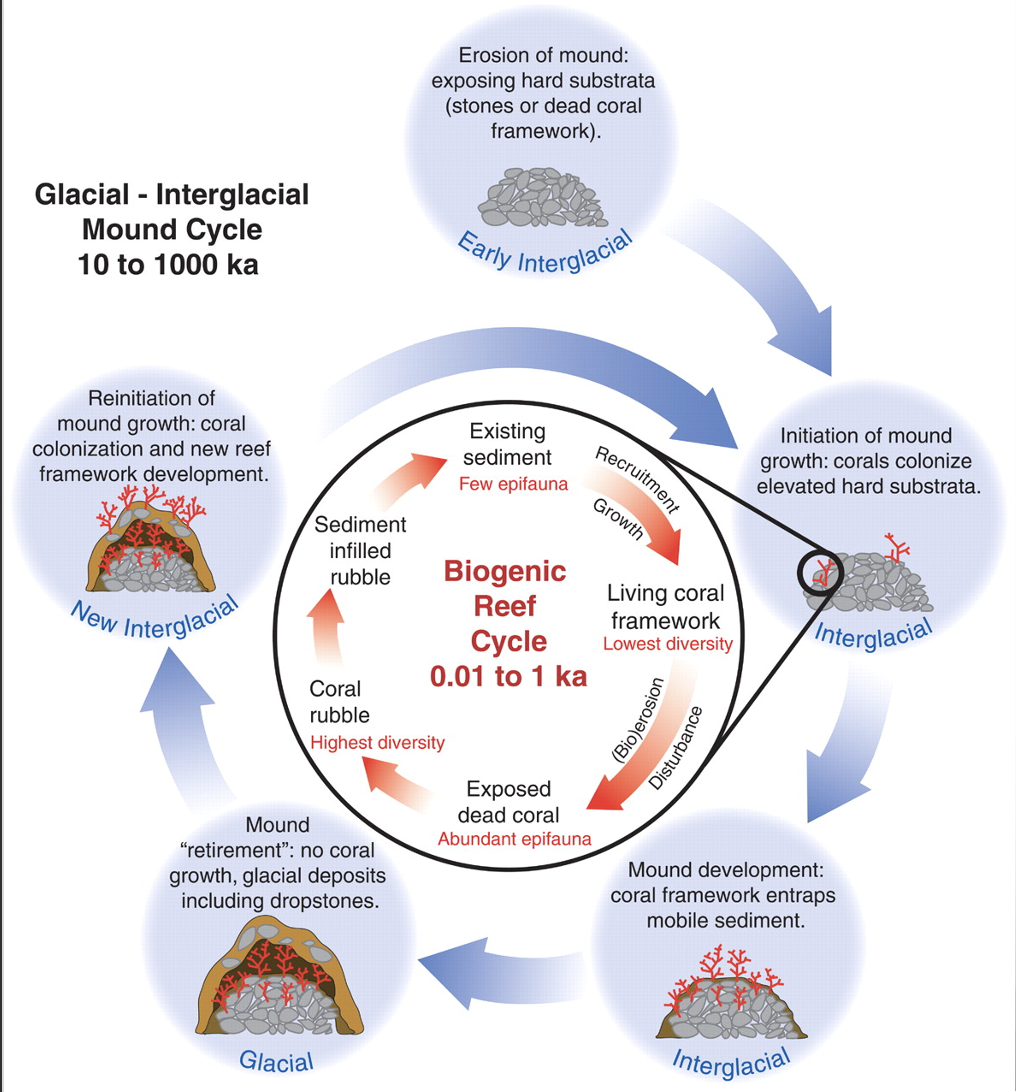
What are the cyclic stages of mound growth/glacial cycle of growth?
Initiation
Development
Retirement
Recolonization
What are the stages of coral life on the biogenic scale?
Hard substrate exists
Corals come in
Loose sediment fills in the areas between corals
Encrusting coraline algae cements loose sediment
Live rock is formed and corals continue to grow
Describe the back reef/ reef flat:
Back reef: located on the sheltered side of the reef
Extends outward from shore
It can be 20-30 meters to 1000’s of meters
May be exposed at low tide
Substrate is coral rock and loose sand
Beds of sea grass develop in sandy regions
Relatively shallow
UV radiation
Experiences widest variations in temperature & salinity
Can heat to over 40°C
1/3 less dissolved O2
Input of fresh rainwater
Protected from waves
Reduced water circulation= accumulation of sediment
Describe the biodiversity of the reef flat:
Two kinds of life:
Species that live exclusively on the reef flat- high tolerance for environmental extremes
Low numbers of spp, but some may be abundant
Well adapted for heat stress, UV radiation, salinity extremes
Low competition
Mollusks, worms, crustaceans, corals
Species for which the reef flat is at the extreme edge of their normal range
Usually live deeper on reef flat
Richer in abundance & diversity
Staghorn coral (sheltered back reef)
Describe the reef crest
Wave action is more vigorous, especially at high tide
Greater water exchange=
Less heat
More O2
Uniform salinity
Describe the biodiversity of the reef crest
Calcareous algae is dominate
Deposit a form of limestone: high-magnesium calcite
“spur & groove system”
Small crabs, shrimp, gastropods
What is the reef crest spur and groove system?
Spurs project into prevailing waters
Grooves (channels) carry water outwards
What coralline algae is in the Indo-Pacific?
Porolithon spp.
What coralline algae is in the Atlantic?
Lithophyllum spp.
What conditions are needed for coralline algae?
Require strong water movement & high aeration
Greater the wave energy= the more widely spaced the algal spurs
Describe the reef slope
Fore-reef
Reef plunges steeply at seaward edge of reef flat/crest
Continuous or irregular
2 slopes on atolls
Maximum corals live here, small fish, large fish, sharks, jacks, barracudas
Greatest diversity at intermediate depths
Greatest competition for space
30-40 meters down sediment starts to accumulate= corals become patchy
Can support corals up to 50-60 meters in Pacific, 100 meters in Atlantic
Sponges, sea whips, sea fans, ahermatypic corals become abundant
What factors does the reef slope zone depend on?
Wave energy- declines with depth
Light- declines with depth
Sedimentation- increases with increased depth
Temperature- gradually decrease, or abruptly decrease across a thermocline
Describe the differences between a shallow and deep reef slope.
Shallow:
Light is abundant
Wave energy prevents sedimentation
Wave energy smashes
Only toughest forms survive the shallows: branching/ table
Deep:
Light is limited
Lots of sedimentation
Leafy corals grow outward to trap light
Also trap sediment so they angle at 45°
Where are all the reef zones?

What are threats to coral reef zonation?
Increased nutrients
Sedimentation
Land use
Disease
Sea level rise
Thermal stress
Increase in tropical storms
The dominant coral reef biota are corals, soft corals, sponges, algae, seagrasses, and mangroves. What do the ratios of each depend on?
-Ocean
-Water quality
-Exposure
-Depth
How thin is the organic living matter layer within reefs compared to the limestone structures they are on?
Comparatively, it is as thin as if you were to spread a jar of peanut butter over a square meter.
What is an aquatic biosedimentary structure?
A reef comprised principally of CaCO3

Hexacoralia is also called ______.
Zooantharia, since zooantharia is in Hexacoralia. They are both in Anthozoa.
Describe Zooantharia/Hexacoralia.
6 or multiple of 6 tentacles
Stony corals (eg. staghorn)
Abundant on reefs
Produce calcium carbonate skeleton
How do coral colonies grow? Why are they advantageous?
Colonies often result from asexual reproduction, particularly from some forms of budding
Common cnidarians, ascidians, ectoprocts
Colony: associations in which the constituent individuals are not completely separated from each other, but are organically connected
Living extensions or secreted material
Produce greater functional units: size
Increased feeding efficiency; facilitate the handling of larger food items
Reduce chances of predation
Allow groups of individuals to specialize for different functions (eg. gastrozoids specialized for food, reproductive polyps)
What is a colony?
Associations in which the constituent individuals are not completely separated
What is aragonite?
It is limestone, specifically limestone that was formed from corals
Describe coral skeletons. What are they called?
Coral skeletons are secreted at the lowest part of the body, forming a cup. The skeletons are called corallite.
How can polyps separate without breaking apart?
Deposit limestone as they grow upward and outward
Divides into two or more daughter polyps
What is a coenosarc? Describe it.
A coenosarc is the connective tissue between polyps
Coenosarc capable of depositing limestone beneath it
Spaces between polyps fill in
Grow upwards
What is intratentacular budding?
Intratentacular budding: polyp constricts in middle to pinch into two polyps
Budding results from division of ring of tentacles

What is extreme intratentacular budding?
Dividing with very little or no pinching off
Results in long ribbons of polyps
Example: Brain corals
Each valley has a ring of tentacles
Each valley has dozens- 100’s of mouths with gastric cavities
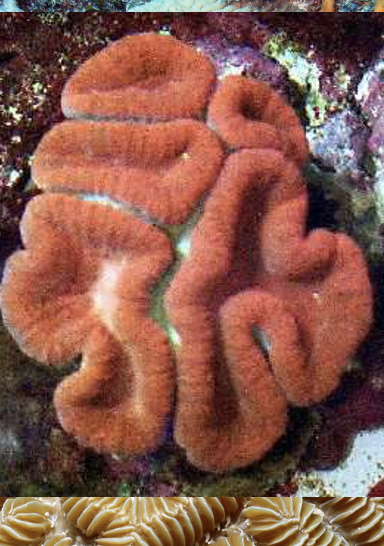
What is extratentacular budding?
Parent corallite produces a daughter corallite external to the wall
What is the difference between intra-tentacular budding and extra tentacular budding?
Intratentacular budding occurs within the polyp wall, whereas the extratentacular budding occurs outside the polyp wall
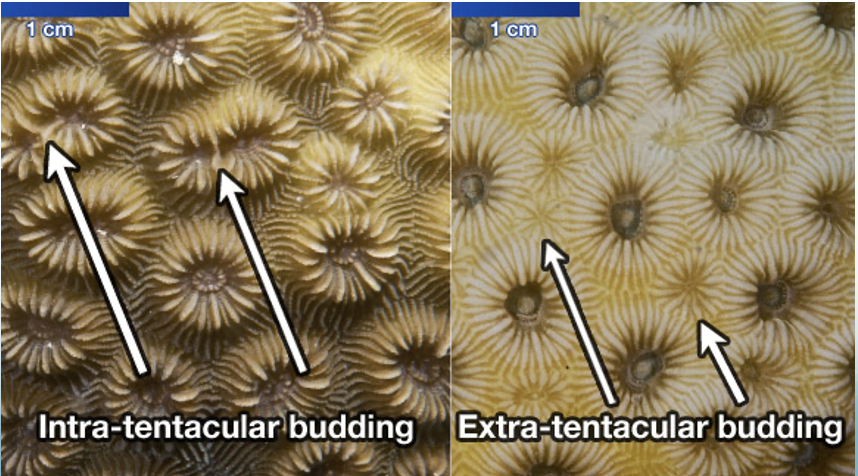
All limestone deposition causes a colony to expand radially. What happens when division and growth is regular?
Smooth, dome-shaped colonies result. Ex: Porites spp.

In what ways can accidental fragmentation occur?
Wave damage
Organisms like sea turtles breaking off pieces of coral
What is an example of radial division nonaccidental fragmentation?
Radial division in Cycloseris fragilis
The coral breaks into pieces on purpose and each piece forms a new coral
What is an example of transverse division nonaccidental fragmentation?
Transverse division in Fungia scutaria
The stalk regenerates a new disk, which breaks off and then another disk is generated
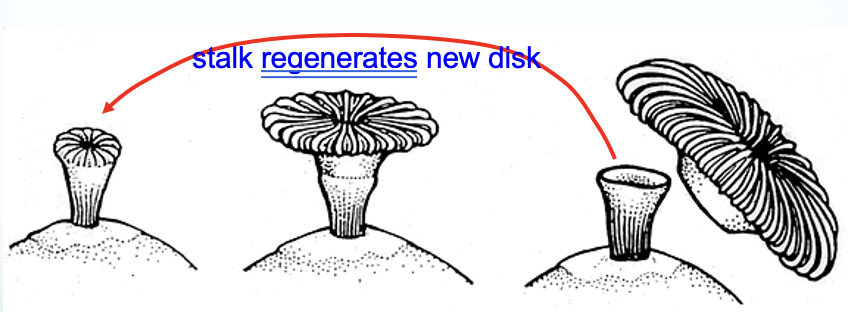
What is a way to visually identify intertentacular between extreme intertentacular budding?
Extreme intertentacular budding typically has polyps inside of the ridges, whereas with regular intertentacular budding, the polyps are on top of the ridges.